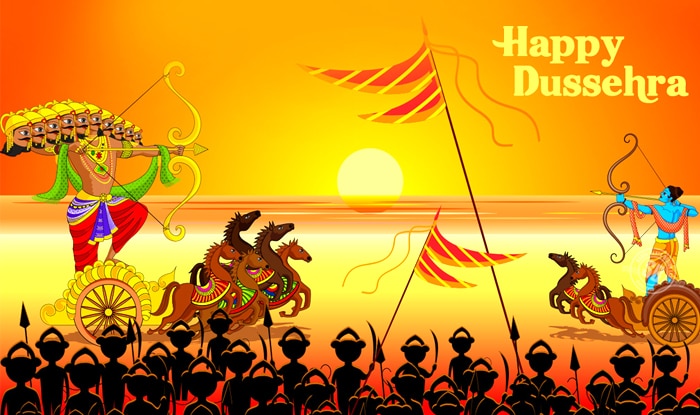The word ‘Dussehra’ signifies the meaning of the festival itself. The word is formed from two words – Dus and Ahara. ‘Dus’ means ten and ‘Ahara’ means day, so tenth day. Another meaning comes from the mythology of the festival where ‘Dus’ signifies the ten heads of Ravana or bad or evil and ‘hara’ means to defeat or removal. In the northern and western states of India Dussehra is celebrated in the honour of Lord Rama who was an avatar of Lord Vishnu. Plays based on Ramayana and Ramcharitmanas called Ramlila are performed at outdoor fairs by theatre troupes. Dussehra is also celebrated as Vijayadashami and also signifies the ****ing of demon Mahishasura by Goddess Durga on the tenth day of Navratri.
Story behind the festival Dussehra related to Lord Rama
According to Hindu mythology, Ravana was a demon king of Lanka, a territory to the south of India who desired Lord Rama’s wife Sita. Ravana kidnapped Sita and took her to his kingdom Lanka where he held her captive. Lord Rama traveled to Lanka with an army of monkeys and with the support of his brother Lakshman and Lord Hanuman he ****ed Ravana on the tenth day of the battle. The first nine days are celebrated as Navratri and the tenth day when Ravana is ****ed Dussehra is celebrated. The Navratri festival is concluded by burning huge and gigantic effigies of the demon Ravana. The ****ing of Ravana signifies the triumph of good over evil.
Story behind the festival Vijayadashmi related to Goddess Durga
In another mythology which is prevalent in the eastern and northern states of India, Goddess Durga ****s the demon Mahishasura to bring peace to Earth. The festival of Navratri is celebrated because here also the battle between the Goddess and the demon spans ten days. On the tenth day, the Goddess Durga ****s Mahishasura and the day are celebrated as Vijayadashmi meaning the ‘victory that was attained on the tenth day’. Each of the preceding nine days of Vijayadashami is dedicated to a specific powerful manifestation of Goddess Durga and people in Northern and Western parts of the region fast while worshipping the nine forms of the Goddess. The eastern and north-eastern parts of India do not fast during Durga Puja as it is a celebratory time for them and they enjoy the festival with much pomp and fervour. Goddess Durga is worshipped for five days in eastern and northeastern parts of the country and on the tenth day, the idol is immersed in water bodies marking the end of festivities.
Dussehra or Vijayadashami or even Bijoya (as Bengalis call it) is one of the most popular and fervently celebrated festivals in India. People play dandiya and garba during the nine days of Navratri while praying to the Goddess. Dussehra and Vijayadashami both celebrate the win of good over evil and signify the man’s need to overcome fear, greed and negative thinking and move towards positive thoughts and deeds.






